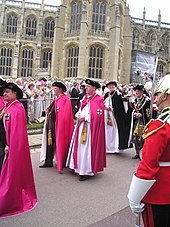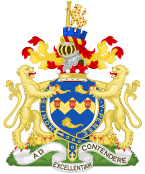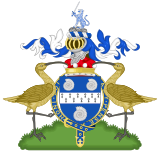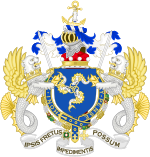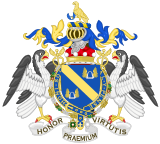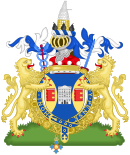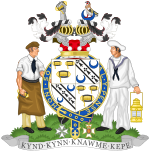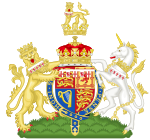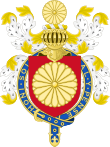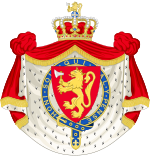Order of the Garter
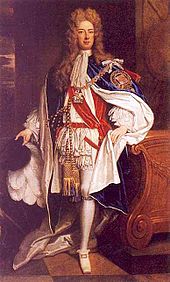
The English King Edward III. 1348 donated Garter (Order of the blue Garter, Order of St. George in England, High Noble Order of the Garter, Order of the Garter, The Most Noble Order of the Garter) is the exclusive Order of the United Kingdom and one of the most respected in Europe. He is one of the three former court orders. To this day he functions as the highest order of knights in the United Kingdom, before the Scottish Thistle Order and the Order of St. Patrick , which is no longer awarded , but after the Victoria Cross and the George Cross as a badge of honor for highest valor.
Medal bearer



Medal winners are the monarch, the Prince of Wales and a maximum of 24 other living knights appointed by the monarch ( Knights and Ladies Companion ), although members of the royal family ( Royal Knights and Ladies Companion ) and foreign knights ( Stranger Knights and Ladies Companion ) are not count. Royal Knights and Ladies Companion and Stranger Knights and Ladies Companion are collectively referred to as the Extra Knights and Ladies Companion . The only non-Christian member is Akihito , the emperor emeritus of Japan. Other European monarchs are members of the order. For example, Margrethe of Denmark and Carl Gustaf of Sweden are members of the order. Foreign monarchs are listed as honorary members ( Stranger Knights and Ladies Companion ) in the order register. The Order of the Garter is a specialty among the European orders of knights, because only foreign monarchs are accepted into the order and not their heirs to the throne as in other European orders. On the occasion of her 80th birthday in April 2006 , Queen Elizabeth II named her sons Andrew, Duke of York , and Edward, Earl of Wessex , Knights of the Order of the Garter. On May 5, 2008, Prince William was accepted as the 1000th member of the Order of the Garter by his grandmother Queen Elizabeth II.
Candidates for the order are personalities who have rendered services to the kingdom or the sovereign.
Emergence
The foundation of the Order of the Garter was announced in 1344 and by the English King Edward III. Completed on January 19, 1348. The order was modeled after King Arthur 's legendary round table . With this order Eduard tried to bind the most important knights of the kingdom closer to himself, the king. One of the first knights of the order was his son Edward of Woodstock , known as "the black prince".
designation
The English name of the Order of the Garter is Most Noble Order of the Garter , whereby garter actually refers to a stocking or knee band . The origin of the name is not clear. According to the most gallant legend, it owes its name to an incident during a dance by King Edward III. with his lover Catherine Grandison, Countess of Salisbury . She lost her blue garter. The king eased the embarrassing situation by picking up the garter and tying himself to his own leg. He is said to have exclaimed: " Honi soit qui mal y pense " (a rogue who thinks evil), the motto of the future order.
According to another tale, after the misfortune of the unfortunate Countess, the king is said to have stood in front of her with his cloak spread out and shielded her when she fastened the garter again, while, turning to the court, he said the well-known saying: "Bad to him who thinks bad ! "Should have done. On the one hand, this was a sign of his chivalrous disposition and the resulting duty to protect people in distress. On the other hand, it would be an expression of the courtoisie with which a troubadour used to worship beautiful women without sexual desire. In truth, however, the motto was more likely to refer to Edward's claim to the French throne.
Patron saint, religious offices
The patron saint of the order is Saint George .
The order has six offices: prelate, chancellor, registrar, herald, usher and secretary. The prelate is always the Bishop of Winchester , one of the highest clergy in the Church of England . The office of chancellor is exercised by one holder of the order, currently James Hamilton, 5th Duke of Abercorn . Registrar is the Dean of Windsor Castle. The office of Herald ( Garter Principal King of Arms ) is entrusted to the head of the highest heraldic authority in England, the College of Arms . One of the other heralds of the college holds the office of secretary. The gentleman Usher of the Black Rod , usually a high-ranking retired officer who also represents the sovereign in the House of Lords , serves as the order servant .
To meet
On a Monday in June of each year, on Garter Day, the Knights of the Order gather in Windsor Castle . After a meal together in the Waterloo Chamber , everyone moves in a kind of procession, led by the sovereign, to the service in St. George's Chapel , in which every knight has his or her fixed place. Until the First World War , the flags of the German knights of the order hung in the chapel, but they were removed from the order register in 1915 due to the spreading anti-German mood. The award of the order is considered to be such a solemn act that the public or the press have no access.
This service always has the following parts:
- introduction
- National anthem
- Introduction of the new members of the order by the head of the order Elisabeth II.
- Our Father
- Blessings on the Order members
- Te Deum laudamus
- Creed
- Reading from the Bible
- Beatus vir
- Thanks for the foundation of the order
- big garter prayer
- anthem
- Graduation blessing
insignia
The insignia of the single-class order consist of a chain of orders ( collane ) with the medal (The George), a breast star with St. George's cross and, at reception ceremonies, for a special costume (blue velvet robes with blue velvet hats and white feather) a blue buckle with the Motto of the order, which is worn by the men on the left knee and by the women (full members since 1987) on the left upper arm. If the collar is not put on, the gem is worn on the blue ribbon that is carried over the left shoulder. The knights, provided they are British and do not hold a higher title, are addressed with the predicate " Sir " or " Lady " and can be followed by the abbreviation KG ( Knight of the Garter ) or LG ( Lady of the Garter ) (so-called . post-nominal ).
Each knight has his own seat in the choir stalls of the chapel. Above him hang his coat of arms on an enamelled metal plate, his banner and the helmet decorations of his coat of arms. The insignia is returned to the order after the knight's death, the banner is given to the family, the helmet gems are given to the College of Arms , only the enamel plate remains in place.
Gem of the Lesser George shoulder strap
Color of the strap, here as a strap buckle
View into the high choir of St. George's Chapel with the helmet jewels above the knight's seat.
Order of the Garter of the Welfs, exhibited at Callenberg Castle
Coat of arms of the current bearers of the Order of the Garter
Women in the Order of the Garter
In the Order of the Garter - in contrast to the great continental orders, the Order of the Golden Fleece (founded in 1430), the Order of Michael (founded in 1469) and the Order of the Holy Spirit (founded in 1578) - women could be accepted in the first century and a half of its existence . King Edward III made this clear by taking in his wife Philippa von Hainaut 10 years after the founding of the order , whereby she was not given the title of "Knight Companion of the Garter", but that of a "Lady of the Garter". In the year before his death he took his only living daughter Isabella - next to his sons Edward of Woodstock (1348, 1376), Lionel of Antwerp , John of Gaunt and Edmund of Langley (all around 1361), the youngest Thomas of Woodstock (* 1355; † 1397) followed in 1380 - also in the order.
Up to 1488 64 women were accepted into the order, whereby the focus is clearly in the reign of Edward's successor Richard II (King 1377-1399) or the reign of his guardian John of Gaunt: 35 of these 64 admissions alone are in these years It should also be noted that "only" 33 men were accepted into the order at the same time. Almost four fifths of the women, 27, were accepted in just four years, 1378, 1384, 1386 and 1399, while the acceptance of the 33 men was continuous over the entire period. Under Richard's successor, Henry IV, another 9 women were added in 1408, after which the influx dried up: from 1420 to 1488 there were only 17 women in 68 years, and at the end of the century the order became pure again Men's society - which was not changed by the fact that England was ruled for a long time by women (including Elizabeth I , Victoria ) in the following centuries . Only with the admission of Alexandra of Denmark , the wife of Victoria's son and successor Edward VII. In 1901, this situation ended.
Nevertheless, "Ladies of the Garter" were not full members ( Companions ) of the order and did not enjoy the same privileges as the "Knights Companion of the Garter", but were only allowed to participate in the ceremonies of the order. This practice was only ended in 1987, when Queen Elizabeth II decreed equal rights for women members of the order by means of an amendment to the statutes. Since then, women have been accepted into the order as “Ladies Companion of the Garter”.
Members of the order
literature
- Diethard Schneider: The English Order of the Garter. Contributions to the creation and development of “The Most Noble Order of the Garter” (1348–1702) with an outlook to 1983 . 2 volumes (4 parts). Schneider-Krause, Bonn 1988.
- The Order of the Garter . In: Heide N. Rohloff (Ed.): A royal millennium. Stagings of a monarchy , catalog and manual for the exhibition of the British Crown Jewels (in replica) [The British Heritage Exhibition], Hanover: Congress Centrum; Tourismus Center, 1997, p. 78f.
- Hugh EL Collins: The Order of the Garter, 1348-1461. Chivalry and Politics in Late Medieval England. Clarendon Press, Oxford 2000, ISBN 0-19-820817-0 .
- William Arthur Shaw: The Knights of England. Volume 1, Sherratt and Hughes, London 1906, pp. I ff.
Web links
- Official site at The Monarchy Today (English)
Individual evidence
- ↑ St. George Windsor February 20, 2009. Retrieved on February 27, 2012 ( Memento of the original from March 6, 2016 in the Internet Archive ) Info: The archive link was inserted automatically and has not yet been checked. Please check the original and archive link according to the instructions and then remove this notice. (PDF; 102 kB)
- ^ Raymond B. Waddington: Elizabeth I and the Order of the Garter. In: The Sixteenth Century Journal. Volume 24, No. 1 (1993), pp. 97-113.
